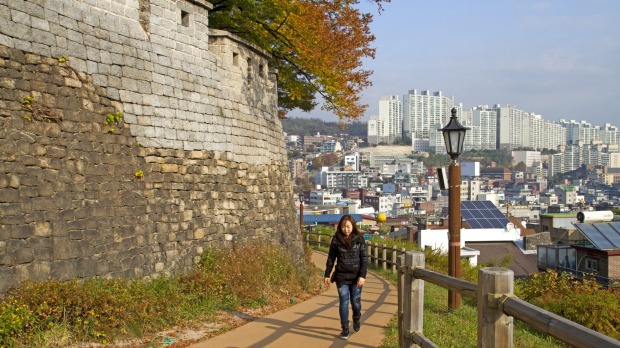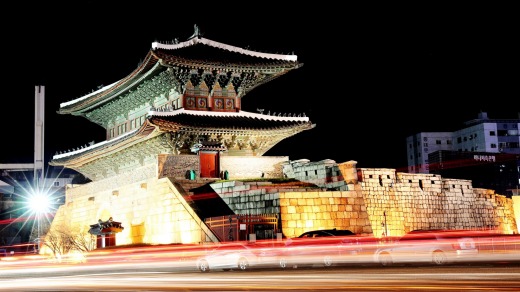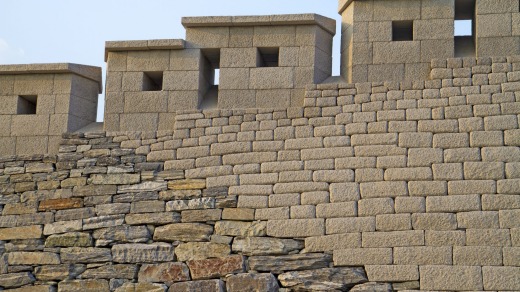
In Asia, China has no monopoly on great walls. Running around the former royal heart of Seoul is what's claimed as the largest remaining city wall in the world.
Built when the Joseon Dynasty moved its capital to Seoul in 1395, the wall today is almost overwhelmed by the modern metropolis, but still snakes around the city like an unobtrusive frame.
Right beside the wall is a trail that runs a literal ring around the South Korean capital. Walk it and you discover that Seoul's City Wall is more than just a line of stones; it's an eye into the city, past and present.

The wall's cornerstones are the four main gates that face the compass cardinal points and once provided entry into the city. In between are four smaller gates and it's at one of these, Hyehwamun, that I start walking.
Immediately the trail begins climbing, rising up the slopes of Naksan, one of four peaks that enclosed Seoul's royal city. The wall rises up and over each of them.
It was designed this way for defence, but today this elevation is the wall's true beauty, providing almost constant views over the city.

The trail runs immediately beside the wall, which is up to 12 metres high and makes an 18.6-kilometre circuit of inner Seoul. Remarkably, it was constructed in less than 100 days by 200,000 conscripted labourers. Less than three decades later, another 320,000 workers were tasked with replacing rammed-earth sections with stone blocks.
There's more to the wall than just stone and city views, however, with worthy diversions along the way. Atop Naksan, I briefly leave the wall, descending steps into Ihwa-dong, a once-impoverished ancient village now brightened by a host of murals, galleries and a handful of cute cafes.
At the base of Naksan, as I walk on, is Seoul's City Wall Museum. Spread over three levels, it tells the tale of the wall in static displays and a wraparound interactive experience that walks step by step along the wall's length. There are sections I won't walk this day, so I stand and watch them roll past me instead.
Across from the museum is the wall's East Gate, still admitting travellers into the city as major roads swirl around it. The whole area inside the gate used to be one large market, but today there are two very different market experiences here.
In sight of the gate is a clutch of fashion malls, including the Dongdaemun Design Plaza, opened in 2014 with an ultra-modern silver design that deliberately set out to become the symbol of Seoul.
A 10-minute walk from here is Gwangjang, a traditional local market that's said to be one of the oldest and largest in South Korea. It's just the spot for a snack of chicken feet or intestines, though I settle for a lunch of mung-bean pancakes and fried pork meatballs washed down with the milky, alcoholic makeolli.
Past East Gate, towards the foot of Namsan mountain, most of the wall has been demolished and consumed by the city. The wall's disappearance in parts hasn't been all ad hoc; for a long time it was policy.
Under Japanese rule, a Wall Disposal Committee was formed in 1907. Sections were demolished to build roads and monuments to Japanese colonial rule. The West Gate disappeared when a streetcar line was widened. By 1970, over one-third of the wall had been removed.
Following a North Korean assassination attempt on the South Korean president in 1968, 10 kilometres of the wall was strengthened and restored. Today, around 70 per cent of the wall – 12.8kilometres – remains.
Crowned by the 236-metre-high N Seoul Tower, Namsan is the most prominent of the wall's four mountains. Its slopes are covered in forest, patterned this day in autumn colours. Though the city surrounds me, the forest mutes its racket, leaving only peace. It's as though I've left Seoul, while still being deep within Seoul.
The wall runs to the very base of the N Seoul Tower, then snakes back down the mountain into the modern city centre. At the base of the climb is the wall's South Gate, a noble piece of the past surrounded by the glass-and-steel business fortresses of the future. It's here that I'm ending my day of walking, having covered around half the wall's length.
If you drive around Seoul, South Gate looks like the anomaly, a run in the stitching of this most modern of Asian cities. But this day, as the sun sets, the gate and the wall – this centuries-long tale told in stone – feel suddenly like the city's very heart.
www.visitkorea.org.au
Korean Air flies daily direct to Seoul Incheon from Sydney, with four flights a week also from Brisbane. www.koreanair.com
The enormous and luxurious Lotte Hotel is an institution in itself in the middle of Seoul's city centre, just a few minutes' walk from the South Gate. www.lottehotel.com/seoul/en.
Full information on the wall can be found at seoulcitywall.seoul.go.kr/front/eng/index.do. A map of the wall is available from the visitor centre in the Dongdaemun Design Plaza.